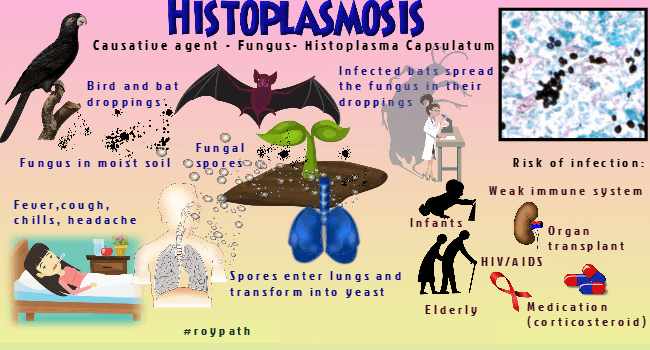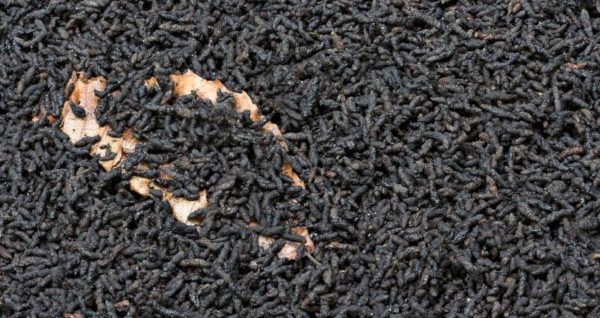While the health risks associated with birds and bat poop are often overstated, large roosting populations can pose a risk of disease to those nearby. The main concern is the potential for disease organisms to grow in droppings, feathers, and debris accumulating under a roost, especially if the roost has been active for an extended period. Additionally, external parasites may become an issue when infested birds or bats leave their roosts or nests, potentially invading buildings and biting people.
Diseases Liked with Bat Poop and Other Bird Droppings
Histoplasmosis

Histoplasmosis is caused by the fungus Histoplasma capsulatum, primarily found in regions drained by the Mississippi and Ohio rivers.
Both humans and animals can contract the disease, which is transmitted to humans through inhalation of spores from soil contaminated by droppings of birds such as pigeons and starlings, as well as other birds and bats.
The soil under a roost must have been enriched by droppings for at least two years for the disease organism to reach significant levels. While typically associated with soil, the fungus can also be found in bat droppings, such as attics.
Histoplasmosis is contracted by inhaling spores of the fungus Histoplasma capsulatum, which are typically found in the air after a roost has been disturbed.
While most infections are mild and may produce no symptoms or a minor influenza-like illness, the disease can cause high fever, blood abnormalities, pneumonia, and even death in rare cases.
In certain regions, such as portions of Illinois, up to 80% of the population have evidence of previous infection. Outbreaks of histoplasmosis have occurred in Central Illinois.
According to the National Institutes of Health (NIH), a potentially blinding eye condition known as presumed ocular histoplasmosis syndrome (OHS) may be caused by the fungus Histoplasma capsulatum (1). The NIH estimates that 4% of individuals exposed to the disease may be at risk of developing OHS.
ALSO READ: Do Owls Poop? Everything You Wanted to Know
Cryptococcosis

According to research, pigeon droppings appear to be the primary source of the disease-causing fungus Cryptococcus neoformans in the environment (2).
The fungus is commonly found in accumulations of droppings around roosting and nesting sites such as attics, cupolas, ledges, and water towers.
It has been found in up to 84% of samples taken from old roosts. Even when old and dry, bird droppings can still pose a significant risk of infection.
Like histoplasmosis, most cases of cryptococcosis are mild and may not produce symptoms. However, individuals with compromised immune systems are more susceptible to infection.
The disease is contracted by inhaling the yeast-like cells of the organism.
There are two forms of cryptococcosis in humans: the generalized form, which begins with a lung infection and spreads to other parts of the body, particularly the central nervous system, and is usually fatal without treatment.
Acne-like skin eruptions or ulcers characterize the cutaneous (skin) form with nodules just under the skin. This form is very rare and does not usually occur without the generalized (systemic) disease.
Outbreaks of multiple cases of cryptococcosis at a single location have not been documented.
ALSO READ: What Are Owl Pallets? You Will Be Surprised to Know
Other Diseases
Other diseases transmitted by birds have a less severe impact on human health. Psittacosis, for example, is typically mild in humans, although rare cases of serious illness can occur (3).
Pigeons and sparrows, along with many other bird species, have also been identified as reservoirs for encephalitis viruses such as West Nile, which mosquitoes transmit.
Bat Poop and Disease

Bats have been linked to a few diseases that can affect humans, such as rabies and histoplasmosis (4). Rabies is a serious and fatal disease, but only about 5% of bats tested are found to be infected with the rabies virus.
However, there has been an increased concern about the risk of rabies transmission following contact with bats in recent years. It should be removed safely if an injured or ill bat is found in or around a building.
The bats should not be touched with bare hands and should be picked up with tongs or a shovel. If a bat has bitten or scratched a person or pet or is found in your home, it should be captured without touching and crushing its head.
If the bat is dead, refrigerate it and then immediately contact your local health department for instructions.
Contact your local animal control officer or the Illinois Department of Natural Resources at 217-785-8774 for information on safe bat capture.
Cases of rabies in bats have been identified in most state regions. In recent years, bats have been the state’s most common animal identified with rabies.
While the risk of histoplasmosis transmission from bat droppings to humans is considered low, it is important to note that fresh bat droppings can contain the fungus that causes histoplasmosis (5), unlike fresh bird droppings.
Additionally, bat droppings do not need to come into contact with soil to pose a risk of disease transmission.
Diseases From Ticks, mites, and other parasites
Bird or bat roosts can harbor parasites that can invade buildings. These parasites can bite and irritate but are unlikely to transmit diseases to humans. The most common roost parasites include the northern fowl mite and chicken mite. Other parasites that may be found in buildings include:
- The pigeon nest bug.
- Bat bug (which is related to the bed bug).
- Soft ticks.
- Biting lice.
- The pigeon flies.
Most parasites associated with bird or bat roosts will die shortly after the birds or bats leave, but some may survive for several weeks.
When birds or bats make a home near buildings, it can lead to a build-up of their droppings, feathers, food, and even dead birds. This can attract insects like flies and beetles, which can become a big problem in the area.
These insects can come inside through open windows or small cracks. To prevent this, it’s important to discourage birds and bats from roosting near buildings.
If insects are still a problem after the birds and bats have been removed, the roost area can be treated with a special spray approved by the U.S. Environmental Protection Agency for controlling pests like fleas, ticks, and mites.
How to Remove and Clean Bird and Bat Droppings
If you find a small number of droppings from a few birds or bats, you can clean it up using soap and water. But, if there are a lot of droppings, it’s best to contact an expert in the field, such as an environmental engineering consultant, for guidance on properly cleaning it up.
- When cleaning up bird or bat droppings, it is important to take precautions to minimize the risk of disease:
- Seal heating and cooling air ducts or shut off the system during the cleanup, and only allow authorized personnel to be present.
- Healthy individuals should do cleanup
- Wear protective gear such as a respirator, disposable gloves, hat, coveralls, and shoe coverings.
- Moisten the droppings with water to keep spores from becoming airborne and keep them wet.
- Place droppings in sealed plastic garbage bags, and rinse the bags outside before placing them in a disposal container.
- Remove protective clothing and wash or shower before leaving the area.
- Check with local government agencies to verify that waste disposal is permissible through standard trash pickup.
- Modify the structure to prevent birds or bats from reestablishing the roost.
SOURCES:
*1- OHS may be caused by the fungus Histoplasma capsulatum. https://www.nei.nih.gov/
*2 -High Prevalence of Cryptococcus neoformans and Isolation of Other Opportunistic Fungi From Pigeon. https://pubmed.ncbi.nlm.nih.gov/31833301/
*3 – Psittacosis, for example, is typically mild in humans, although rare cases of serious illness can occur. https://www.health.nsw.gov.au/
*4 – Risk for Rabies transmission from encounters with Bats. https://www.ncbi.nlm.nih.gov/
*5 – Risk of histoplasmosis transmission from bat droppings to humans. https://www.cdc.gov/




